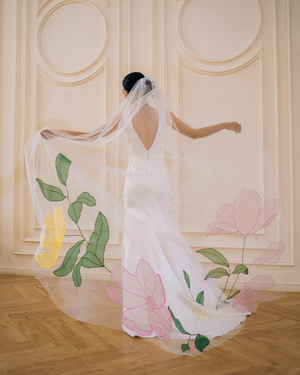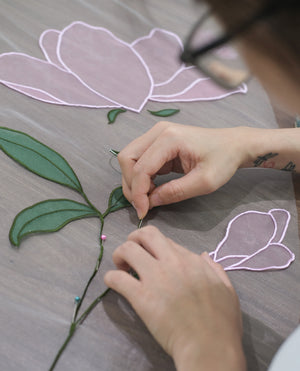You may also like
Lace and chiffon veils stand out as two classic options for brides choosing the perfect finishing touch to their wedding look. Lace veils bring ornate patterns and a sense of tradition, while chiffon veils create a soft, flowing finish with modern appeal. Both textiles produce stunning effects, but in quite different ways.
This article will explain the features of lace and chiffon veils, their strengths, and their limitations. It will discuss style, design, comfort, and style so that brides can decide which fabric best suits their gown, venue, and personal scheme.
Lace Veils in Detail
Origins and Symbolism
Lace has been part of bridal fashion for centuries, often seen as a symbol of refinement and heritage. Its use in veils dates back to European traditions, where lace represented wealth, artistry, and a sense of formality. The fabric was often reserved for weddings of high social standing, which helped solidify its association with elegance and tradition.
Beyond aesthetics, lace has carried cultural and emotional meaning. In many families, lace veils are treasured heirlooms passed down through generations, adding sentiment to a bride’s wedding day. These heirloom veils represent continuity and respect for family history while also connecting a bride to past traditions.
In modern weddings, lace still retains its symbolic weight, but it has also adapted to suit new interpretations of style. Today’s brides choose lace veils not only for their decorative value but also for the sense of timelessness they bring, linking a contemporary ceremony to customs that have stood for centuries.

Our Bride: Erika Riego de Dios - CA, USA. Veil: Erika. Photo: Matthew David
Lace Varieties and Their Effect
Chantilly Lace: Known for its light, delicate patterns and fine net background, Chantilly lace creates a soft, romantic effect. It often features floral motifs and adds a subtle elegance that pairs beautifully with flowing gowns and vintage-inspired looks. Brides who want a dreamy, feminine finish often gravitate toward this style.
Alençon Lace: Sometimes called the “queen of lace,” Alençon is characterized by raised corded outlines and rich detailing. It has a more structured and bold look compared to Chantilly, making it ideal for brides who want their veil to stand out as a statement piece. Its durability also makes it suitable for veils intended as keepsakes.
Guipure Lace: Unlike other laces with delicate netting, Guipure lace consists of heavier motifs linked by fine stitches. This creates a dramatic, textured appearance that brings depth and dimension to a veil. Brides who prefer strong patterns and a more defined style often choose Guipure, especially for outdoor or cathedral ceremonies where details need to be visible from afar.
Corded Lace: Corded lace uses thicker threads to outline motifs, adding subtle relief and structure. This makes the lace appear more defined, giving veils an elegant frame around the bride’s silhouette. It works particularly well for edging on cathedral-length veils, where detail at the hem enhances the drama of the gown.

BRITTNIE | Cathedral Floral Lace Veil with Blusher
Styling with Lace Veils
Lace veils naturally suit gowns with matching or complementary detailing. A lace-trimmed veil works seamlessly with dresses that already feature lace, creating a unified look. Brides who wear plain gowns often choose lace veils to add texture and contrast, elevating a minimalist dress with carefully placed decoration.
The type of lace also determines the styling outcome. A Chantilly-edged fingertip veil creates a light and graceful look, while a Guipure-trimmed cathedral veil offers bold impact. Placement matters as well: lace along the edge frames the face and shoulders, while all-over lace can transform the veil into a dramatic feature on its own.
Venue and setting also influence styling choices. Lace veils with ornate detail often look striking in grand churches and traditional settings, while lighter lace patterns work well in outdoor ceremonies where movement and airiness are key. Brides should consider the overall theme of the wedding to ensure the lace complements, rather than competes with, their gown and setting.

Practical Considerations
Lace veils, while beautiful, can feel heavier than those made from chiffon or tulle. Brides should consider how long they plan to wear the veil, as ornate lace designs may add noticeable weight, particularly in cathedral lengths. Comfort becomes especially important during long ceremonies and receptions.
Maintenance is another factor. Lace, by its nature, has openwork patterns that can snag on jewelry or beading. Careful handling is essential, both before and during the wedding day. Brides who plan to preserve their veil as a family keepsake will also need to invest in proper storage to prevent discoloration and damage over time.
Finally, cost is an important practical point. Handcrafted lace and rare varieties often come at a higher price, reflecting the craftsmanship involved. However, many brides see this as an investment in a meaningful accessory that elevates their look and carries lasting sentimental value. Brides with budget considerations may opt for veils with lace edging rather than full lace coverage, striking a balance between effect and affordability.

Our Bride: Virginia Wood - CA, USA. Veil: Custom Linda veil - Chapel length: 90”
The Charm of Chiffon Veils
Fabric Characteristics
Chiffon is a sheer, lightweight fabric woven in a way that gives it a smooth and airy feel. Unlike lace, which is defined by pattern, chiffon is valued for its softness and fluid quality. Brides often choose it for its natural drape, which allows the veil to fall gracefully without adding bulk. Its semi-transparent finish makes it especially flattering in photographs, as it filters light gently around the bride’s face and gown.
There are two main types used in veils: silk chiffon and synthetic chiffon. Silk chiffon has a luxurious hand-feel with an elegant luster, but it is more delicate and requires careful handling. Synthetic chiffon, often made of polyester, is slightly sturdier and more resistant to wrinkling, making it easier to manage for long ceremonies or destination weddings. Both options deliver the characteristic softness brides look for, though silk is often favored by those seeking a premium, heirloom-quality veil.
Styling with Chiffon Veils
Chiffon’s simplicity makes it a versatile choice for many gown styles. Brides who choose minimalist dresses often favor chiffon because the fabric complements without competing. It pairs especially well with sleek slip gowns, column silhouettes, or modern tailored styles where the goal is clean lines and understated elegance.
For boho-inspired or outdoor weddings, chiffon veils work beautifully with relaxed styles, as the fabric’s movement mirrors the natural flow of an open-air setting. The way chiffon catches the breeze creates a romantic and almost weightless effect, ideal for garden or beach ceremonies.
In terms of veil length, chiffon adapts to both shorter and longer options. Fingertip-length chiffon veils offer a simple frame to the gown, while cathedral-length versions provide dramatic yet soft lines as the bride walks down the aisle. Because of its smooth texture, chiffon can also take on embellishments such as beaded trims, pearls, or lace edging without losing its natural flow.
Useful Aspects
Comfort is one of chiffon’s strongest advantages. Its light weight means brides can wear it for hours without strain. This is especially important in warmer climates, where heavier fabrics may feel stifling. Brides planning outdoor weddings often appreciate how chiffon keeps them cool while still providing coverage.
Durability is another factor. While chiffon is delicate, it resists snagging more than lace, making it easier to handle around jewelry or heavily detailed gowns. Polyester chiffon in particular is less prone to wrinkling and can withstand travel better, which is valuable for destination weddings where packing space and garment care may be limited.
Cost plays a role in decision-making as well. Synthetic chiffon is generally more affordable, making it accessible to brides on a wide range of budgets. Silk chiffon, by contrast, is considered a luxury option, carrying a higher price but offering unmatched softness and natural sheen. Brides who wish to pass down their veil as an heirloom often choose silk for its elegance, while those focused on practicality lean toward synthetic.
Chiffon’s combination of lightness, adaptability, and ease of wear makes it one of the most approachable veil fabrics available. Brides can rely on it for a comfortable experience without sacrificing elegance, regardless of their wedding style or venue.
Head-to-Head Comparison of Lace vs Chiffon Veils


ELA | Lace Wedding Veil
Appearance and Texture
Lace veils carry a rich visual impact because of their decorative motifs and textured patterns. Depending on the type of lace, they can appear soft and delicate or bold and defined. Lace tends to frame the gown with detail, which can either echo existing embellishment or stand as a feature in its own right. Brides seeking a veil that feels ornamental and traditional often lean toward lace for its ability to add visual depth.
Chiffon veils, on the other hand, are about simplicity. Their surface is smooth, even, and free of heavy decoration. This gives chiffon a quiet elegance that allows the gown to remain the focal point. It offers a softer, understated look that appeals to brides who prefer a modern or minimalist style. The absence of pattern means chiffon veils work almost universally with different dress fabrics without competing for attention.
Movement and Drape
Lace veils tend to have more structure because of the density of the fabric and the embroidery or corded detail. When draped, they maintain shape and add definition around the gown. Longer lace veils often fall in sculpted lines that hold their form, creating a sense of grandeur. This makes lace particularly suitable for formal settings where a more stately effect is desired.

ELA | Lace Wedding Veil
Chiffon is prized for its fluidity. The fabric moves easily with the bride, catching air and flowing softly with each step. This creates a romantic, ethereal impression, especially in outdoor weddings where even a light breeze can bring the veil to life. The natural softness of chiffon makes it especially striking in photographs, as it frames the bride with a gentle, almost weightless motion.
Comfort and Practicality
In terms of comfort, chiffon holds a clear advantage. Its light weight makes it easy to wear for long ceremonies and receptions. Brides often forget they are wearing it, which is particularly helpful in warmer climates or during extended celebrations. Maintenance is also simpler, as chiffon is less likely to catch on beading or jewelry.
Lace, while beautiful, can feel heavier depending on how much embroidery or appliqué it contains. Brides choosing cathedral-length lace veils should be prepared for a more noticeable weight. Lace is also more prone to snags because of its openwork structure, meaning it requires extra care when paired with detailed gowns or ornate accessories. However, many brides are willing to accept this for the elegance and tradition lace provides.

Our Bride: McKhayla, from South Carolina, USA. Photo: Emmy Kienast. Veil: Brittnie.
Cost and Accessibility
Lace veils vary widely in cost depending on the type of lace used. Handmade European lace, such as French Alençon, is considered premium and can significantly raise the price of a veil. Machine-made lace or lace trims are more affordable alternatives, offering a similar look at lower cost. The investment often reflects craftsmanship, with handmade lace prized for its artistry and lasting value.
Chiffon veils are generally more accessible. Polyester chiffon is widely available and cost-effective, making it a practical choice for brides working within a tighter budget. Silk chiffon, while more expensive, still tends to be less costly than high-end lace. This makes chiffon a versatile option that spans both everyday budgets and luxury choices. Brides often appreciate that chiffon offers elegance without the same financial commitment lace sometimes requires.
How to Choose Between Lace and Chiffon
Choosing between lace and chiffon veils requires a thoughtful look at how each fabric pairs with the gown, the venue, and the bride’s personal style. These are the few areas you need to think about out of the many:
Match to Gown Style
The dress should be the starting point. Lace veils complement gowns with lace detailing, creating a coordinated look that ties together fabric and design. Brides wearing ornate dresses often favor lace trims instead of full lace coverage so the veil adds detail without competing with embellishment. Chiffon veils are well suited to clean, modern gowns made from satin, crepe, or other smooth fabrics. They add softness while keeping the focus on the silhouette.

Our Bride: Nicole Ritonja - Canada. Veil: Leanne. Cathedral length. Photo: Nicole Amanda.
Match to Venue and Season
The setting plays a major role in how the veil appears. Lace veils feel natural in formal spaces such as cathedrals, historic halls, or elegant ballrooms. Their detail and structure echo the atmosphere of traditional venues. Chiffon veils, with their fluid movement, shine in outdoor settings where breeze and light bring the fabric to life. They are especially popular for garden and beach weddings as well as ceremonies in warmer climates because of their breathability.
Adapt to Personal Style
A bride’s personal style should ultimately guide the decision. Lace is often chosen by brides who value tradition and want a veil with rich detail and timeless appeal. Chiffon is a favorite for those who prefer minimalism, softness, and a contemporary look. Both choices are beautiful, but each speaks to a different expression of style.
Useful Hints for Making Choices
Trying both fabrics is the most reliable way to see how they change the overall look. Veils of the same length in lace and chiffon can feel entirely different once paired with the dress. Brides should also think about comfort. If the veil will stay on throughout the day, chiffon may feel lighter and easier to wear. Lace may be better suited for the ceremony and portraits before switching to a shorter or simpler style for the reception.
In the end, the best choice is the one that feels natural with the gown, reflects the setting, and aligns with the bride’s personal vision for the day. Both lace and chiffon carry qualities that can transform a look, but the right veil is the one that supports the entire wedding experience.
Check Out Your Lace & Chiffon Options at Tara Bridal Today!
At Tara Bridal, artisans cut and stitch every lace and chiffon veil by hand, calibrating weight, drape, and movement so it floats with you. We hand-place lace motifs, micro-rolled hems, and color-match to your gown. Our float-cut patterns and balanced comb placement are the quiet secret behind that airy silhouette.
Choose us for made-to-measure sizing, bespoke trims, and sustainable craft. You get stylist support, swatches on request, and worldwide delivery. Chat with a stylist, request swatches, and commission your lace or chiffon veil today.








